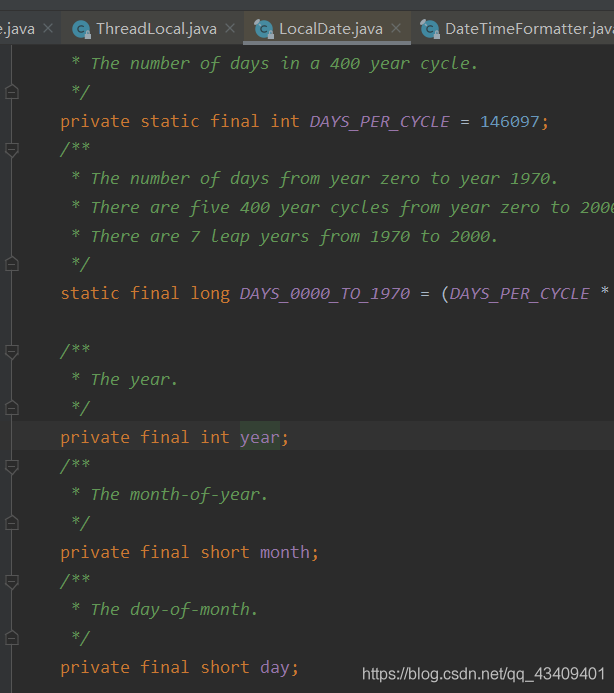怎么在Java8中实现一个线程安全日期类
这期内容当中小编将会给大家带来有关怎么在Java8中实现一个线程安全日期类,文章内容丰富且以专业的角度为大家分析和叙述,阅读完这篇文章希望大家可以有所收获。
LocalDateTime
Java8新特性之一,新增日期类。
在项目开发过程中经常遇到时间处理,但是你真的用对了吗,理解阿里巴巴开发手册中禁用static修饰SimpleDateFormat吗
通过阅读本篇文章你将了解到:
为什么需要LocalDate、LocalTime、LocalDateTime【java8新提供的类】
Java8新的时间API的使用方式,包括创建、格式化、解析、计算、修改
可以使用Instant代替 Date,LocalDateTime代替 Calendar,DateTimeFormatter 代替 SimpleDateFormat。
SimpleDateFormat线程不安全
Date如果不格式化,打印出的日期可读性差
Tue Sep 10 09:34:04 CST 2019使用SimpleDateFormat对时间进行格式化,但SimpleDateFormat是线程不安全的 SimpleDateFormat的format方法最终调用源码:
private StringBuffer format(Date date, StringBuffer toAppendTo, FieldDelegate delegate) { // Convert input date to time field list calendar.setTime(date); boolean useDateFormatSymbols = useDateFormatSymbols(); for (int i = 0; i < compiledPattern.length; ) { int tag = compiledPattern[i] >>> 8; int count = compiledPattern[i++] & 0xff; if (count == 255) { count = compiledPattern[i++] << 16; count |= compiledPattern[i++]; } switch (tag) { case TAG_QUOTE_ASCII_CHAR: toAppendTo.append((char)count); break; case TAG_QUOTE_CHARS: toAppendTo.append(compiledPattern, i, count); i += count; break; default: subFormat(tag, count, delegate, toAppendTo, useDateFormatSymbols); break; } } return toAppendTo; }注意calendar.setTime(date);,Calendar类是里面基本都是final修饰的,calendar是共享变量,并且这个共享变量没有做线程安全控制。当多个线程同时使用相同的SimpleDateFormat对象【如用static修饰的SimpleDateFormat,一般会封装在工具类,复用】调用format方法时,多个线程会同时调用calendar.setTime方法,可能一个线程刚设置好time值另外的一个线程马上把设置的time值给修改了导致返回的格式化时间可能是错误的。
在多并发情况下使用SimpleDateFormat需格外注意:
SimpleDateFormat除了format方法是线程不安全以外,parse方法也是线程不安全的。parse方法实际调用alb.establish(calendar).getTime()方法来解析,alb.establish(calendar)方法里主要完成了
重置日期对象cal的属性值
使用calb(calBuilder)中属性设置cal
返回设置好的cal对象
但是这三步不是原子操作
SimpleDateFormat如何保证线程安全
避免线程之间共享一个SimpleDateFormat对象,每个线程使用时都创建一次SimpleDateFormat对象 => 创建和销毁对象的开销大
对使用format和parse方法的地方进行加锁 => 线程阻塞性能差
使用ThreadLocal保证每个线程最多只创建一次SimpleDateFormat对象 => 较好的方法
Date对时间处理比较麻烦,比如想获取某年、某月、某星期,以及n天以后的时间,如果用Date来处理的话真是太难了,你可能会说Date类不是有getYear、getMonth这些方法吗,获取年月日很Easy,但都被弃用了啊
Java8全新的日期和时间API
在使用Java程序操作数据库时,我们需要把数据库类型与Java类型映射起来。下表是数据库类型与Java新旧API的映射关系:
| 数据库 | 对应Java类(旧) | 对应Java类(新) |
| DATETIME | java.util.Date | LocalDateTime |
| DATE | java.sql.Date | LocalDate |
| TIME | java.sql.Time | LocalTime |
| TIMESTAMP | java.sql.Timestamp | LocalDateTime |
LocalDate
只会获取年月日
//获取当前年月日 LocalDate localDate = LocalDate.now(); //构造指定的年月日 LocalDate localDate1 = LocalDate.of(2019, 9, 10); //获取年、月、日、星期几 int year = localDate.getYear(); int year1 = localDate.get(ChronoField.YEAR); Month month = localDate.getMonth(); int month2 = localDate.get(ChronoField.MONTH_OF_YEAR); int day = localDate.getDayOfMonth(); int day1 = localDate.get(ChronoField.DAY_OF_MONTH); DayOfWeek dayOfWeek = localDate.getDayOfWeek(); int dayOfWeek1 = localDate.get(ChronoField.DAY_OF_WEEK);LocalTime
只会获取几点几分几秒
//创建LocalTime LocalTime localTime = LocalTime.of(13, 51, 10); LocalTime localTime1 = LocalTime.now(); //获取小时 int hour = localTime.getHour(); int hour1 = localTime.get(ChronoField.HOUR_OF_DAY); //获取分 int minute = localTime.getMinute(); int minute1 = localTime.get(ChronoField.MINUTE_OF_HOUR); //获取秒 int second = localTime.getSecond(); int second1 = localTime.get(ChronoField.SECOND_OF_MINUTE);LocalDateTime
获取年月日时分秒,等于LocalDate+LocalTime
//创建对象 LocalDateTime localDateTime = LocalDateTime.now(); LocalDateTime localDateTime1 = LocalDateTime.of(2019, Month.SEPTEMBER, 10, 14, 46, 56); //LocalDate+LocalTime-->LocalDateTime LocalDateTime localDateTime2 = LocalDateTime.of(localDate, localTime); LocalDateTime localDateTime3 = localDate.atTime(localTime); LocalDateTime localDateTime4 = localTime.atDate(localDate); //获取LocalDate LocalDate localDate2 = localDateTime.toLocalDate(); //获取LocalTime LocalTime localTime2 = localDateTime.toLocalTime();ZonedDateTime
LocalDateTime总是表示本地日期和时间,要表示一个带时区的日期和时间,我们就需要ZonedDateTime。
可以简单地把ZonedDateTime理解成LocalDateTime加ZoneId。ZoneId是java.time引入的新的时区类,注意和旧的java.util.TimeZone区别。
创建一个ZonedDateTime对象
// 默认时区ZonedDateTime zbj = ZonedDateTime.now(); // 用指定时区获取当前时间ZonedDateTime zny = ZonedDateTime.now(ZoneId.of("America/New_York"));结果:
2019-09-15T20:58:18.786182+08:00[Asia/Shanghai]
2019-09-15T08:58:18.788860-04:00[America/New_York]
另一种创建方式是通过给一个LocalDateTime附加一个ZoneId,就可以变成ZonedDateTime:
LocalDateTime ldt = LocalDateTime.of(2019, 9, 15, 15, 16, 17);ZonedDateTime zbj = ldt.atZone(ZoneId.systemDefault());ZonedDateTime zny = ldt.atZone(ZoneId.of("America/New_York"));时区转换
要转换时区,首先我们需要有一个ZonedDateTime对象,然后,通过withZoneSameInstant()将关联时区转换到另一个时区,转换后日期和时间都会相应调整。
ZonedDateTime zbj = ZonedDateTime.now(ZoneId.of("Asia/Shanghai"));// 转换为纽约时间:ZonedDateTime zny = zbj.withZoneSameInstant(ZoneId.of("America/New_York"));ZonedDateTime仍然提供了plusDays()等加减操作。
要特别注意,时区转换的时候,由于夏令时的存在,不同的日期转换的结果很可能是不同的。这是北京时间9月15日的转换结果:
2019-09-15T21:05:50.187697+08:00[Asia/Shanghai]
2019-09-15T09:05:50.187697-04:00[America/New_York]
这是北京时间11月15日的转换结果:
2019-11-15T21:05:50.187697+08:00[Asia/Shanghai]
2019-11-15T08:05:50.187697-05:00[America/New_York]
两次转换后的纽约时间有1小时的夏令时时差。涉及到时区时,千万不要自己计算时差,否则难以正确处理夏令时。有了ZonedDateTime,将其转换为本地时间就非常简单:
ZonedDateTime zdt = ...LocalDateTime ldt = zdt.toLocalDateTime();转换为LocalDateTime时,直接丢弃了时区信息。
Instant
获取秒数或时间戳
//创建Instant对象 Instant instant = Instant.now(); //获取秒数 long currentSecond = instant.getEpochSecond(); //获取毫秒数 long currentMilli = instant.toEpochMilli(); long l = System.currentTimeMillis();System.currentTimeMillis()也可以获取毫秒数。
日期计算
LocalDate、LocalTime、LocalDateTime、Instant为不可变对象,修改这些对象对象会返回一个副本
增加、减少年数、月数、天数等,以LocalDateTime为例
//修改LocalDate、LocalTime、LocalDateTime、Instant LocalDateTime localDateTime = LocalDateTime.of(2019, Month.SEPTEMBER, 10, 14, 46, 56); //增加一年 localDateTime = localDateTime.plusYears(1); localDateTime = localDateTime.plus(1, ChronoUnit.YEARS); //减少一个月 localDateTime = localDateTime.minusMonths(1); localDateTime = localDateTime.minus(1, ChronoUnit.MONTHS);//通过with修改某些值 //修改年为2020 localDateTime = localDateTime.withYear(2020); //修改为2022 localDateTime = localDateTime.with(ChronoField.YEAR, 2022);//还可以修改月、日有些时候想知道这个月的最后一天是几号、下个周末是几号,通过提供的时间和日期API可以很快得到答案
LocalDate localDate = LocalDate.now();LocalDate localDate1 = localDate.with(TemporalAdjusters.firstDayOfYear());比如通过firstDayOfYear()返回了当前年的第一天日期,还有很多方法这里不在举例说明
格式化时间
DateTimeFormatter默认提供了多种格式化方式,如果默认提供的不能满足要求,可以通过DateTimeFormatter的ofPattern方法创建自定义格式化方式
LocalDate localDate = LocalDate.of(2019, 9, 10);String s1 = localDate.format(DateTimeFormatter.BASIC_ISO_DATE);String s2 = localDate.format(DateTimeFormatter.ISO_LOCAL_DATE);//自定义格式化DateTimeFormatter dateTimeFormatter = DateTimeFormatter.ofPattern("dd/MM/yyyy");String s3 = localDate.format(dateTimeFormatter);解析时间
和SimpleDateFormat相比,DateTimeFormatter是线程安全的
LocalDate localDate1 = LocalDate.parse("20190910", DateTimeFormatter.BASIC_ISO_DATE);LocalDate localDate2 = LocalDate.parse("2019-09-10", DateTimeFormatter.ISO_LOCAL_DATE);DateTimeFormatter替代SimpleDateFormat
使用旧的Date对象时,我们用SimpleDateFormat进行格式化显示。使用新的LocalDateTime或ZonedLocalDateTime时,我们要进行格式化显示,就要使用DateTimeFormatter。
和SimpleDateFormat不同的是,DateTimeFormatter不但是不变对象,它还是线程安全的。因为SimpleDateFormat不是线程安全的,使用的时候,只能在方法内部创建新的局部变量。而DateTimeFormatter可以只创建一个实例,到处引用。
//构造器1:传入格式字符串DateTimeFormatter formatter = DateTimeFormatter.ofPattern("yyyy-MM-dd HH:mm:ss");//构造器2:传入格式字符串和地区DateTimeFormatter formatter = DateTimeFormatter.ofPattern("E, yyyy-MMMM-dd HH:mm:ss", Locale.US);DateTimeFormatter formatter = DateTimeFormatter.ofPattern("E, yyyy-MMMM-dd HH:mm:ss", Locale.CHINA);DateTimeFormatter底层原理
DateTimeFormatter线程安全的?为什么?
源码:

很明显,通过final修饰类,不可被继承,final修饰变量,做成了不可变类,类似String,不仅线程安全而且高效。全局可以只有一个对象,多个线程引用。
format和parse线程安全替代
使用LocalDateTime的format和parse方法,传入对应的DateTimeFormatter对象参数,实际也是调用DateTimeFormatter的format和parse方法,实现日期格式化和解析,是线程安全的。
DateTimeFormatter类解析LocalDateTime中的日期变量,转成StringBuilder返回。LocalDateTime等新出的日期类全是final修饰的类,不能被继承,且对应的日期变量都是final修饰的,也就是不可变类。赋值一次后就不可变,不存在多线程数据问题。

上述就是小编为大家分享的怎么在Java8中实现一个线程安全日期类了,如果刚好有类似的疑惑,不妨参照上述分析进行理解。如果想知道更多相关知识,欢迎关注编程网行业资讯频道。
免责声明:
① 本站未注明“稿件来源”的信息均来自网络整理。其文字、图片和音视频稿件的所属权归原作者所有。本站收集整理出于非商业性的教育和科研之目的,并不意味着本站赞同其观点或证实其内容的真实性。仅作为临时的测试数据,供内部测试之用。本站并未授权任何人以任何方式主动获取本站任何信息。
② 本站未注明“稿件来源”的临时测试数据将在测试完成后最终做删除处理。有问题或投稿请发送至: 邮箱/279061341@qq.com QQ/279061341













